 At the turn of the 20th century almost every major North American city relied on the streetcar as its primary mode of public transportation. New York would open the first portion of its subway system in 1904, but the demise of trolly-based transportation took place at the hands of the bus more than anything else.
At the turn of the 20th century almost every major North American city relied on the streetcar as its primary mode of public transportation. New York would open the first portion of its subway system in 1904, but the demise of trolly-based transportation took place at the hands of the bus more than anything else.
Persistent conspiracy theories allege that the decline of the North American streetcar system can be traced to a plot by General Motors as well as numerous oil and tire companies to spur automobile dependency in the U.S., an urban mythology which has its roots in the very real charges that were brought against GM for monopolizing the sale of buses during the post-Depression period.
 Streetcar systems across the States dropped like flies from the late 1930s through to the '50s when the bus rose to dominance as the surface vehicle of choice for public transit in mid-sized American. Even Los Angeles used to be a streetcar town until the early 1960s, when both the Pacific Electric and the Los Angeles Railway ceased operations.
Streetcar systems across the States dropped like flies from the late 1930s through to the '50s when the bus rose to dominance as the surface vehicle of choice for public transit in mid-sized American. Even Los Angeles used to be a streetcar town until the early 1960s, when both the Pacific Electric and the Los Angeles Railway ceased operations.
Cities like Chicago, Brooklyn, Boston, Philadelphia and Pittsburgh all made large-scale purchases of President's Conference Committee (PCC) streetcars when they were released in the 1930s, but by 1954 Toronto had the largest fleet on the continent as the TTC purchased used cars from American cities that were retiring the electric railways (e.g. Ceveland, Kansas City, and Cincinnati).
 The streetcar was yet to be an endangered species at the halfway point of the century, but its decline was in full swing. Following the release and popularity of the PCC cars, only a handful of U.S. cities updated their fleets with newer rolling stock.
The streetcar was yet to be an endangered species at the halfway point of the century, but its decline was in full swing. Following the release and popularity of the PCC cars, only a handful of U.S. cities updated their fleets with newer rolling stock.
By the '70s and 1980s, the streetcar was deemed an obsolete in North America, remaining only in a handful of cities like Boston, Philadelphia, and San Francisco where legacy lines were upgraded to separated light rail.
Toronto was the only city that bucked the trend by investing heavily in its existing streetcar system during this period. It certainly didn't seem like this would be the case following the 1966 opening of the Bloor-Danforth subway line, which replaced the busiest streetcar route in the city. Plans were announced in the fall 1971 to scrap the remaining service on other streets across the city by 1980.
As is well known among local transit history buffs, a group of civic activists led by Institute of Child Studies professor Andrew Biemiller and public transit expert Steve Munro formed the group "Streetcars for Toronto," which successfully lobbied for the retention of the streetcar system in Toronto. In the years that followed, the TTC bolstered its existing fleet of PCC cars with the new Canadian Light Rail Vehicle (CLRV).
 The rest is history as far as Toronto's streetcar system goes. The TTC still operates almost 189 CRLV streetcars to go along with 48 ARLV versions (i.e. the double cars), a collective fleet which is slowly (very slowly) being replaced by the new Flexity models, which will take the city through many decades of service.
The rest is history as far as Toronto's streetcar system goes. The TTC still operates almost 189 CRLV streetcars to go along with 48 ARLV versions (i.e. the double cars), a collective fleet which is slowly (very slowly) being replaced by the new Flexity models, which will take the city through many decades of service.
So often in Toronto we're charged with emulating other cities, but this is an obvious and perhaps even crucial example in which our city has proved to be trailblazer. As light rail makes a major comeback in North America, it's hard to imagine what would have happened if Toronto had killed its streetcar fleet back the '70s.
It's worth noting that the comeback of the streetcar in most American cities doesn't exactly resemble Toronto's primarily shared right-of-way system, but the predominant thinking behind the return of the streetcar as a mode of transit is greatly indebted to Toronto's system in its downtown focus, short stop lengths, and greater efficiency at moving people than buses.
 Streetcar systems in cities like Portland, Salt Lake City (the S Line), Seattle, Washington (DC Streetcar) and most recently Kansas City have similarities to Toronto, while the proposed Los Angeles Streetcar is almost unthinkable without the longevity of Toronto's system to point to as justification for the desirability of such transit in densely populated areas.
Streetcar systems in cities like Portland, Salt Lake City (the S Line), Seattle, Washington (DC Streetcar) and most recently Kansas City have similarities to Toronto, while the proposed Los Angeles Streetcar is almost unthinkable without the longevity of Toronto's system to point to as justification for the desirability of such transit in densely populated areas.
Not everyone is a cheerleader for the streetcar in Toronto, and the term has carried heavy political implications for many years, but there's civic pride to be had in the daring manner in which our city stuck with this mode of transportation.
The streetcar is an enduring icon of Toronto's urban landscape, and also a reminder of our willingness to go our own way.
Photos via the Toronto Archives and Jason Doss.
 Some of Toronto's most recognizable buildings are made all the more alluring based on the forbidden areas they boast. Think of the observation deck at Commerce Court North, for instance. Once the most popular of its kind and host to tens of thousands of visitors a year, it's been closed to the public for decades due to safety concerns.
Some of Toronto's most recognizable buildings are made all the more alluring based on the forbidden areas they boast. Think of the observation deck at Commerce Court North, for instance. Once the most popular of its kind and host to tens of thousands of visitors a year, it's been closed to the public for decades due to safety concerns. The first thing you notice upon entrance is the massive underside of the roof. As part of a building
The first thing you notice upon entrance is the massive underside of the roof. As part of a building  When you open one up, you're able to stare down at the assembly through a decorative metal grate that gives the distinct feeling that you're a spy or part of a security detail keeping clandestine tabs on the proceedings below. I only managed to get a crappy cell phone pic, but you get the sense of how novel the view is.
When you open one up, you're able to stare down at the assembly through a decorative metal grate that gives the distinct feeling that you're a spy or part of a security detail keeping clandestine tabs on the proceedings below. I only managed to get a crappy cell phone pic, but you get the sense of how novel the view is. Alas, there was never enough money to install the clock, so the building now boasts a huge rose window where it was planned to go. Early drawings of Queen's Park give a indication of what it might have looked like with the huge clock.
Alas, there was never enough money to install the clock, so the building now boasts a huge rose window where it was planned to go. Early drawings of Queen's Park give a indication of what it might have looked like with the huge clock.  On the eastern side is something a bit stranger. People familiar with the history and architecture of the building tend to call it the "mystery room." It's essentially an enclosed terrace with a solely decorative purpose. Given that Queen's Park was designed in the
On the eastern side is something a bit stranger. People familiar with the history and architecture of the building tend to call it the "mystery room." It's essentially an enclosed terrace with a solely decorative purpose. Given that Queen's Park was designed in the  This is surely one of the best restricted views of Toronto that there is. Elevated above five storeys, you can look straight down University Avenue into the heart of the city. To walk around up there for a few minutes is to realize how amazing it would be to somehow open the space up for public use. In fact, the entire attic offers amazing views southward.
This is surely one of the best restricted views of Toronto that there is. Elevated above five storeys, you can look straight down University Avenue into the heart of the city. To walk around up there for a few minutes is to realize how amazing it would be to somehow open the space up for public use. In fact, the entire attic offers amazing views southward. This is not an entirely unvisited place. Along with the occasional film crew, it's obvious from the various names and initials carved out in dust throughout the attic that security guards, building workers, and even provincial politicians have made their way up here.
This is not an entirely unvisited place. Along with the occasional film crew, it's obvious from the various names and initials carved out in dust throughout the attic that security guards, building workers, and even provincial politicians have made their way up here.  Today in Toronto there are quite a few people standing on a stage to entertain you. Whether it be poetry, comedy, ukuleles or an explosive metal concert from Black Sabbath, just sit back and appreciate the brave men and women in this city putting it all out there to give you a show.
Today in Toronto there are quite a few people standing on a stage to entertain you. Whether it be poetry, comedy, ukuleles or an explosive metal concert from Black Sabbath, just sit back and appreciate the brave men and women in this city putting it all out there to give you a show. Want to win the ultimate furniture shopping spree? Elte MKT has a diverse selection of contemporary furniture at price points lower than most other shops in the area. Sofas, sectionals, coffee tables and beds are just some of what you'll find here along with more than 2,000 rugs in stock. And we have a $1000 gift card from Elte MKT to giveaway to one lucky reader.
Want to win the ultimate furniture shopping spree? Elte MKT has a diverse selection of contemporary furniture at price points lower than most other shops in the area. Sofas, sectionals, coffee tables and beds are just some of what you'll find here along with more than 2,000 rugs in stock. And we have a $1000 gift card from Elte MKT to giveaway to one lucky reader.  It's scary to shop for shoes online, so one digital retailer opened a storefront in Toronto to let you browse IRL. This newly opened bricks-and-mortar shop stocks items from big brands as well as pieces from local designers.
It's scary to shop for shoes online, so one digital retailer opened a storefront in Toronto to let you browse IRL. This newly opened bricks-and-mortar shop stocks items from big brands as well as pieces from local designers. This week on DineSafe inspectors seemed to concentrate on the east side of the city. Broadview's Chinos Locos and well-established banh mi shop Rose's Vietnamese Sandwiches are among the eateries sporting conditional passes this week.
This week on DineSafe inspectors seemed to concentrate on the east side of the city. Broadview's Chinos Locos and well-established banh mi shop Rose's Vietnamese Sandwiches are among the eateries sporting conditional passes this week. This famous St. Lawrence Market restaurant still has lineups after all these years. Tourists and locals alike know to hit this spot for lobster rolls, fish fry baskets, grilled seafood over salad, crab cakes, chowders and more.
This famous St. Lawrence Market restaurant still has lineups after all these years. Tourists and locals alike know to hit this spot for lobster rolls, fish fry baskets, grilled seafood over salad, crab cakes, chowders and more.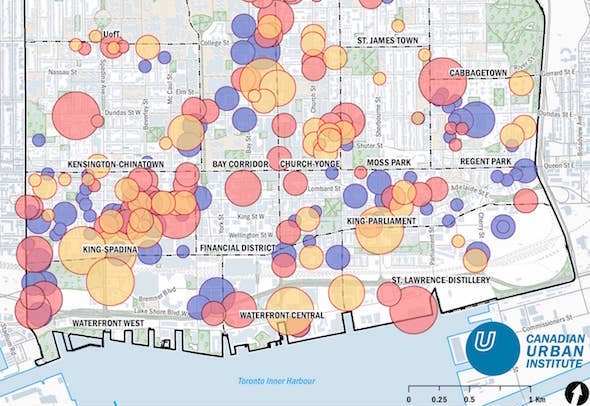 Those who live in Toronto know that the city's population
Those who live in Toronto know that the city's population 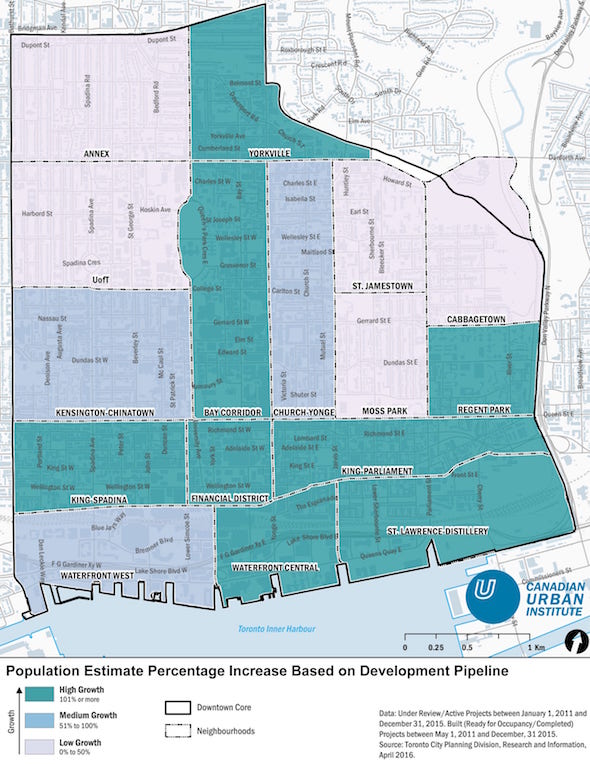 There's plenty of interesting information about each area in the report, but the bird's eye view is perhaps most fascinating. Without recent census data as a guide, the study uses development pipeline data to track "all built, active, and under review projects over a five-year timeframe, 2011 to 2015."
There's plenty of interesting information about each area in the report, but the bird's eye view is perhaps most fascinating. Without recent census data as a guide, the study uses development pipeline data to track "all built, active, and under review projects over a five-year timeframe, 2011 to 2015."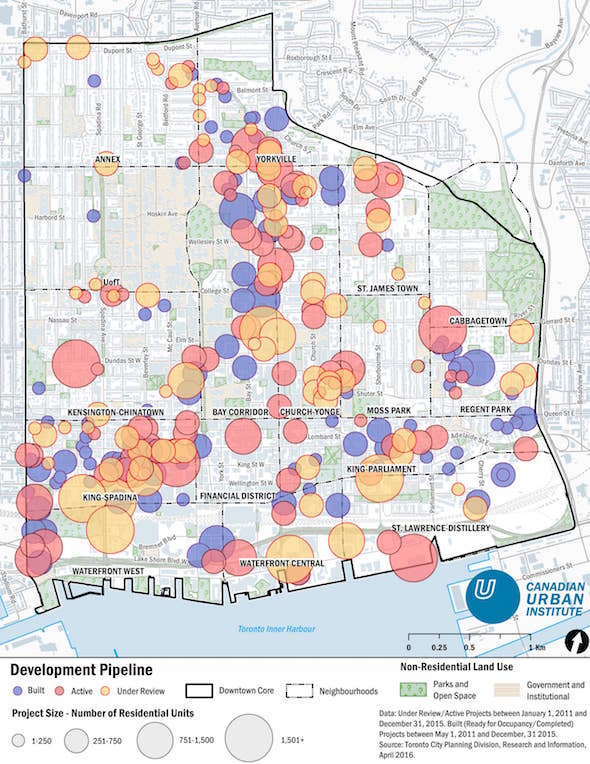 "There were a total of 27,150 built residential units in the development pipeline dataset for the Downtown, which when added to the 2011 base population of 199,405 is the equivalent of an estimated population downtown in 2015 between 242,845 to 245,830.
"There were a total of 27,150 built residential units in the development pipeline dataset for the Downtown, which when added to the 2011 base population of 199,405 is the equivalent of an estimated population downtown in 2015 between 242,845 to 245,830.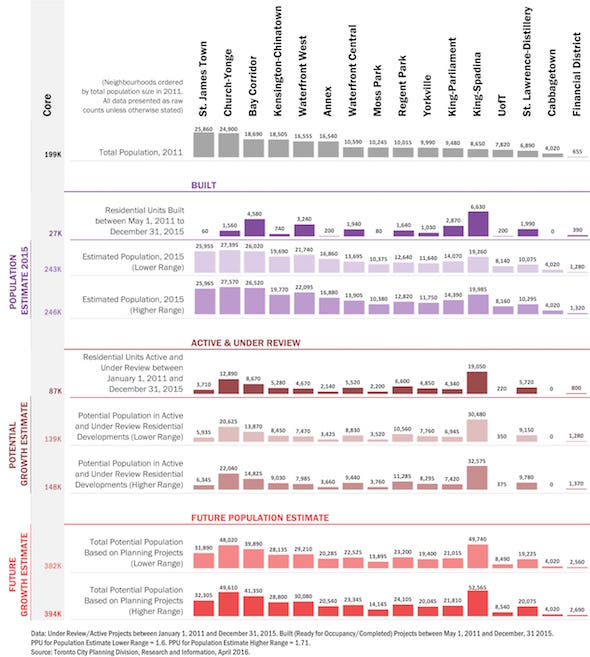 Obviously this isn't the most rigorous way to estimate population given the other variables involved (e.g. whether built units will be occupied), but it does paint an intriguing picture of a city in the midst of a boom.
Obviously this isn't the most rigorous way to estimate population given the other variables involved (e.g. whether built units will be occupied), but it does paint an intriguing picture of a city in the midst of a boom. A number of high-profile Toronto restaurants are pitching in to help raise money for central Italy, the area
A number of high-profile Toronto restaurants are pitching in to help raise money for central Italy, the area  September might signal the end of summer, but it's a huge month for events in Toronto. From
September might signal the end of summer, but it's a huge month for events in Toronto. From  The best grilled cheese sandwich in Toronto will satisfy your cravings for that straightforward but awesome combination of bread and gooey cheese. Find this childhood favourite on lunch menus citywide where it's often upgraded with a few slices of tomato, strips of bacon, or a smear of sweet chutney.
The best grilled cheese sandwich in Toronto will satisfy your cravings for that straightforward but awesome combination of bread and gooey cheese. Find this childhood favourite on lunch menus citywide where it's often upgraded with a few slices of tomato, strips of bacon, or a smear of sweet chutney. There's something happening in Toronto right now, and it's very childish.
There's something happening in Toronto right now, and it's very childish. On Saturday, 2,500 cider lovers took over Yonge-Dundas Square to celebrate the fruity, effervescent alcoholic beverage that's all the rage these days.
On Saturday, 2,500 cider lovers took over Yonge-Dundas Square to celebrate the fruity, effervescent alcoholic beverage that's all the rage these days. "It's amazing to me how people come into the bar and that's their first experience of cider, or at least their first experience of cider other than the big commercial ones that aren't a good indication of what cider is," he says.
"It's amazing to me how people come into the bar and that's their first experience of cider, or at least their first experience of cider other than the big commercial ones that aren't a good indication of what cider is," he says. Along with an increase in options, more customers seem to be ordering cider at Bar Volo now, especially those who are looking for a gluten-free alternative to beer. Morana doesn't think it's just a seasonal trend - cider is popular in the winter too.
Along with an increase in options, more customers seem to be ordering cider at Bar Volo now, especially those who are looking for a gluten-free alternative to beer. Morana doesn't think it's just a seasonal trend - cider is popular in the winter too. Today in Toronto Yeezy and his floating stage descend upon the city for the first night of his two-show stint, Meghan Trainor hits the Molson Amp, and there's a night market at Drake One Fifty. It's a late summer Tuesday, why not enjoy it?
Today in Toronto Yeezy and his floating stage descend upon the city for the first night of his two-show stint, Meghan Trainor hits the Molson Amp, and there's a night market at Drake One Fifty. It's a late summer Tuesday, why not enjoy it? The great thing about Toronto is there are always newcomers flooding in to elevate the city's food scene. And now chef operating in a newish Korean restaurant is here to show us how it's done when it comes to kimchi fries, Korean fried chicken, and sneaky beef.
The great thing about Toronto is there are always newcomers flooding in to elevate the city's food scene. And now chef operating in a newish Korean restaurant is here to show us how it's done when it comes to kimchi fries, Korean fried chicken, and sneaky beef.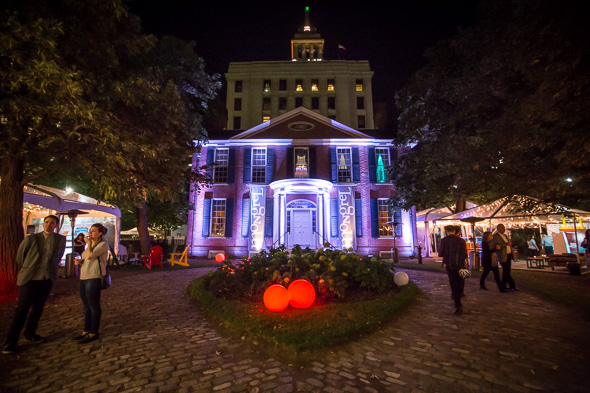 Get ready to go star-gazing at Queen and University next week because the Campbell House Museum will play host to a number of actors, directors and filmmakers during TIFF.
Get ready to go star-gazing at Queen and University next week because the Campbell House Museum will play host to a number of actors, directors and filmmakers during TIFF. With French-influenced dishes that offer well-balanced flavours and a menu that's constantly changing, this dinner destination that's named after the owner's grandparents is sure to become a neighbourhood gem.
With French-influenced dishes that offer well-balanced flavours and a menu that's constantly changing, this dinner destination that's named after the owner's grandparents is sure to become a neighbourhood gem. What could be better than a large corner lot atop the
What could be better than a large corner lot atop the  While there's no denying the spot is unique, it could be a bit too much for those buyers looking for a
While there's no denying the spot is unique, it could be a bit too much for those buyers looking for a  The place boasts a renovated kitchen and floor-to-ceiling windows in the living room and bedrooms. There are some interesting centre rooms with only skylights for natural light, and a massive fitness room on the lower level. But the real selling point? The perfect view of Lake Ontario - and a perch just above the 'Bluffs.
The place boasts a renovated kitchen and floor-to-ceiling windows in the living room and bedrooms. There are some interesting centre rooms with only skylights for natural light, and a massive fitness room on the lower level. But the real selling point? The perfect view of Lake Ontario - and a perch just above the 'Bluffs. SPECS
SPECS NOTABLE FEATURES
NOTABLE FEATURES GOOD FOR
GOOD FOR MOVE ON IF
MOVE ON IF







 Would you live in this unique Scarborough home? Let us know in the comments.
Would you live in this unique Scarborough home? Let us know in the comments.  Contrary to popular belief, there are some free events at the Toronto International Film Festival. But to access them, you might need to wait in line.
Contrary to popular belief, there are some free events at the Toronto International Film Festival. But to access them, you might need to wait in line. Photo via
Photo via  It's almost the most wonderful time of the year in Toronto. That's right, TIFF kicks off next week and it's set to transform our city into a glittery, celebrity-filled hot spot, especially for the first four days of the festival when five blocks of King Street become a pedestrian-only promenade.
It's almost the most wonderful time of the year in Toronto. That's right, TIFF kicks off next week and it's set to transform our city into a glittery, celebrity-filled hot spot, especially for the first four days of the festival when five blocks of King Street become a pedestrian-only promenade.  There will also be supplemental buses running, but be prepared for a significantly longer commute than usual.
There will also be supplemental buses running, but be prepared for a significantly longer commute than usual.